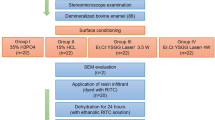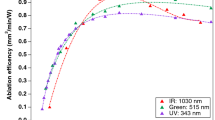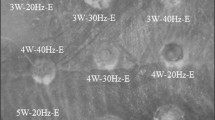Abstract
The aim of the study was to investigate the efficiency of caries removal employing an ultrashort pulsed laser (USPL) and to compare the results regarding to the ablation rate of sound enamel and dentin including surface texture. The study was performed with 59 freshly extracted carious human teeth. Two cavities with an edge length of 1 × 1 mm per tooth were created: one in the dental decay and one in sound hard tissue. For this purpose a 9-W Nd:YVO4 laser with a center wavelength of 1,064 nm and a pulse duration of 8 ps at a repetition rate of 500 kHz was used. A scanner system moved the laser beam across the surface with a scan speed of 2,000 mm/s. Ablated volume and roughness R z of the cavity ground were measured using an optical profilometer. Subsequently, the specimens were cut to undecalcified sections for histological investigations. The removal of dental decay (dentin, 14.9 mm3/min; enamel, 12.8 mm3/min) was significantly higher (p < 0.05) compared to the removal of sound tissues (dentin, 4.2 mm3/min; enamel, 3.8 mm3/min). The arithmetic means of the surface roughness R z were 8.5 μm in carious enamel, 15.43 μm in carious dentin, 4.83 μm in sound enamel and 5.52 μm in sound dentin. Light microscopic investigations did not indicate any side effects in the surrounding tissues. Regarding the ablation rate of dental decay using the USPL system, caries removal seems to be much more efficient for cavity preparation.







Similar content being viewed by others
References
Neev J, Pham K, Lee JP, White JM (1996) Dentin ablation with three infrared lasers. Lasers Surg Med 18(2):121–128
Hibst R, Keller U (1989) Experimental studies of the application of the Er:YAG laser on dental hard substances: I. Measurement of the ablation rate. Lasers Surg Med 9:338–344
Keller U, Hibst R (1989) Experimental studies of the application of the Er:YAG laser on dental hard substances: II. Light microscopic and SEM investigations. Lasers Surg Med 9:345–351
Hossain M, Nakamura Y, Yamada Y, Kimura Y, Matsumoto N, Matsumoto K (1999) Effects of Er, Cr:YSGG laser irradiation in human enamel and dentin: ablation and morphological studies. J Clin Laser Med Surg 17:155–159
de Almeida Neves A, Coutinho E, Cardoso MV, Lambrechts P, Van Meerbeek B (2011) Current concepts and techniques for caries excavation and adhesion to residual dentin. J Adhes Dent 13(1):7–22
Eberhard J, Eisenbeiss AK, Braun A, Hedderich J, Jepsen S (2005) Evaluation of selective caries removal by a fluorescence feedback-controlled Er:YAG laser in vitro. Caries Res 39:496–504
Tao YC, Fried D (2008) Selective removal of natural occlusal caries by coupling near-infrared imaging with a CO2 Laser. Proc Soc Photo Opt Instrum Eng Mar 6843:68430I–68430I8. doi:10.1117/12.778790
Celiberti P, Francescut P, Lussi A (2006) Performance of four dentine excavation methods in deciduous teeth. Caries Res 40:117–123
de Almeida Neves A, Coutinho E, De Munck J, Van Meerbeek B (2011) Caries-removal effectiveness and minimal-invasiveness potential of caries-excavation techniques: a micro-CT investigation. J Dent 39:154–162. doi:10.1016/j.jdent.2010.11.006
Lizarelli RF, Kurachi C, Misoguti L, Bagnato VS (1999) Characterization of enamel and dentin response to Nd:YAG picosecond laser ablation. J Clin Laser Med Surg 17:127–131
Frentzen M, Koort HJ (1990) Lasers in dentistry: new possibilities with advancing laser technology? Int Dent J 40:323–323
Niemz MH (1995) Cavity preparation with the Nd:YLF picosecond laser. J Dent Res 74:1194–1199
Diels JC, Rudolph W (2006) Ultrashort laser pulse phenomena, 2nd edn. Academic Press (Elsevier Inc.), San Diego, pp 370–371
Schelle F, Polz S, Haloui H, Braun A, Dehn C, Frentzen M, Meister J (2013) Ultrashort pulsed laser (USPL) application in dentistry: basic investigations of ablation rates and thresholds on oral hard tissue and restorative materials. Lasers Med Sci. doi:10.1007/s10103-013-1315-4
Meister J, Schelle F, Beier I, Bourauel C, Frentzen M, Kraus D (2013) Influence of USP laser radiation on cell morphology: HaCaT and MG-63 cell lines for bone and soft tissue modelling in dentistry. In: Rechmann P, Fried D (ed) Lasers in dentistry XIX, Proc SPIE 8566:85660F-1–85660F-13
Ishii K, Saiki M, Yoshikawa K, Yasuo K, Yamamoto K, Awazu K (2011) Ablation of demineralized dentin using a mid-infrared tunable nanosecond pulsed laser at 6 μm wavelength range for selective excavation of carious dentin. Conf Proc IEEE Eng Med Biol Soc 2011:318–321
Aoki A, Ishikawa I, Yamada T, Otsuki M, Watanabe H, Tagami J, Ando Y (1998) Comparison between Er:YAG laser and conventional technique for root caries treatment in vitro. J Dent Res 77:1404–1414
Osuka K, Amagai T, Kukidome N, Takase Y, Aida S, Hirai Y (2009) Effect of dentin hardness on ablation rate with Er:YAG laser. Photomed Laser Surg 27:395–399
Niemz MH (1996) Laser–tissue interactions, fundamentals and applications. Springer, Berlin, pp 45–147
Bello-Silva MS, Wehner M, Eduardo CP, Lampert F, Poprawe R, Hermans M, Esteves-Oliveira M (2012) Precise ablation of dental hard tissues with ultra-short-pulsed lasers. Preliminary exploratory investigation on adequate laser paramters. Lasers Med Sci. doi:10.1007/s10103-012-1107-7
Lizarelli RF, Costa MM, Carvalho-Filho E, Nunes FD, Bagnato VS (2008) Selective ablation of dental enamel and dentin using femtosecond laser pulses. Laser Pys Lett 5:63–69
McDonald A, Claffey N, Pearson G, Blau W, Setchell D (2002) The effect of Nd:YAG radiation at nanosecond pulse duration on dentine crater depth. Biomaterials 23:51–58
Kim BM, Feit MD, Rubenchik AM, Joslin EJ, Celliers PM, Eichler J, Da Silva LB (2001) Influence of pulse duration on ultrashort laser pulse ablation of biological tissues. J Biomed Opt 6:332–338
Braun A, Krillke RF, Frentzen M, Bourauel C, Stark H, Schelle F (2013) Heat generation caused by ablation of dental hard tissues with an ultrashort pulse laser (USPL) system. Lasers Med Sci. doi:10.1007/s10103-013-1344-z
Braun A, Wehry RJ, Brede O, Dehn C, Frentzen M, Schelle F (2012) Heat generation caused by ablation of restorative materials with an ultrashort pulse laser (USPL) system. Lasers Med Sci 27:297–303
Schelle F, Meister J, Oehme B, Frentzen M (2012) Transmission of 1064 nm laser radiation during ablation with an ultra-short pulsed laser (USPL) system. In: Rechmann P, Fried D (ed) Lasers in Dentistry XVIII, Proc SPIE 8208:82080J-1–82080J-8
Duck FA (1990) Physical properties of tissue. Academic Press, London, pp 9–42
Ivanenko MM, Hering P (1998) Hard-tissue ablation with a mechanically Q-switched CO2 laser. Thermal therapy, laser welding, and tissue interaction. Proc SPIE 3565:110–115
Fried D, Glena RE, Featherstone JDB, Seka W (1995) Nature of light scattering in dental enamel and dentin at visible and near-infrared wavelengths. Appl Opt 34(7):1278–1285. doi:10.1364/AO.34.001278
Wigdor H (1997) Uses of lasers in dentistry. In: Clayman L, Kuo P (eds) Lasers in maxillofacial surgery and dentistry. Thieme Med Publishers, New York, pp 127–135
Tao YC, Fried D (2009) Near-infrared image-guided laser ablation of dental decay. J Biomed Opt 14:054045
Cerci BB, Roman LS, Guariza-Filho O, Camargo ES, Tanaka OM (2012) Dental enamel roughness with different acid etching times: atomic force microscopy study. Eur J Gen Dent 1:187–191
Carstensen W (1992) The effects of different phosphoric acid concentrations on surface enamel. Angle Orthod 62(1):51–58
Buonocore MG, Matsui A, Gwinnett AJ (1968) Penetration of resin dental materials into enamel surfaces with reference to bonding. Arch Oral Biol 13(1):61–67
Barkmeier WW, Erickson RL, Kimmes NS, Latta MA, Wilwerding TM (2009) Effect of enamel etching time on roughness and bond strength. Oper Dent 34:217–222
Montes MA, de Goes MF, Sinhoreti MA (2005) The in vitro morphological effects of some current pre-treatments on dentin surface: a SEM evaluation. Oper Dent 30:201–212
Jeffrey IWM, Lawrenson B, Longbottom C, Saunders EM (1990) CO2 laser application to the mineralized dental tissues—the possibility of iatrogenic sequelae. J Dent 18(1):24–30
Arcoria CJ, Steele RE, Wagner MJ (1991) Enamel surface and dental pulp response to coaxial carbon dioxide-neodymium:YAG laser irradiation. J Dent 19:85
Lan WH (2003) A comparison of bond strengths following treatment with Er:YAG laser and phosphoric acid. Int Congr Ser 1248:51–59
Staninec M, Gardner AK, Le CQ, Sarma AV, Fried D (2006) Adhesion of composite to enamel and dentin surfaces irradiated by IR laser pulses of 0.5-35 micros duration. J Biomed Mater Res B Appl Biomater 79(1):193–201
Chang KK, Staninec M, Chan KH, Fried D (2011) Adhesion studies on dental enamel surfaces irradiated by a rapidly scanned carbon dioxide laser. Proc Soc Photo Opt Instrum Eng 7884:78840S. doi:10.1117/12.878892
Staninec M, Xie J, Le CQ, Fried D (2003) Influence of an optically thick water layer on the bond-strength of composite resin to dental enamel after IR laser ablation. Lasers Surg Med 33(4):264–269. doi:10.1002/lsm.10229
Hedayatollahnajafi S, Staninec M, Watanabe L, Lee C, Fried D (2009) Dentin bond strength after ablation using a CO2 laser operating at high pulse repetition rates. Proc Soc Photo Opt Instrum Eng 7162:71620F. doi:10.1117/12.816862
Sheth KK, Staninec M, Sarma AV, Fried D (2004) Selective targeting of protein, water, and mineral in dentin using UV and IR pulse lasers: the effect on the bond strength to composite restorative materials. Lasers Surg Med 35(4):245–253
Staninec M, Marshall GW, Hilton JF, Pashley DH, Gansky SA, Marshall SJ, Kinney JH (2002) Ultimate tensile strength of dentin: evidence for a damage mechanics approach to dentin failure. J Biomed Mater Res 63(3):342–345
Ceballo L, Toledano M, Osorio R, Tay FR, Marshall GW (2002) Bonding to Er-YAG-laser-treated dentin. J Dent Res 81(2):119–122
Soares LES, Brugnera Junior A, Zanin F, Pacheco MTT, Martin AA (2006) Molecular analysis of Er:YAG laser irradiation on dentin. Braz Dent J 17(1):15–19
Song BC, Cho YG, Lee MS (2011) Effect of Er:YAG lasing on the dentin bonding strength of two-step adhesives. J Korean Acad Conserv Dent 36(5):409–418. doi:10.5395/JKACD.2011.36.5.409
Igarashi A, Kato J, Takase Y, Hirai Y (2008) Influence of output energy and pulse repetition rate of the Er:YAG laser on dentin ablation. Photomed Laser Surg 26:189–195
Corona SA, de Souza AE, Chinelatti MA, Borsatto MC, Pécora JD, Palma-Dibb RG (2007) Effect of energy and pulse repetition rate of Er:YAG laser on dentin ablation ability and morphological analysis of the laser-irradiated substrate. Photomed Laser Surg 25:26–33
Acknowledgments
The authors would like to thank the Federal Ministry of Education and Research Germany (Grant No. 13 N10190) for the financial support. Moreover, thanks are given to the staff of our laboratory (Silke van Dyck, Imke Beier, Beate Schiermeyer-Dunkhase and Florian Schelle) for preparing the samples.
Author information
Authors and Affiliations
Corresponding author
Additional information
An erratum to this article can be found at http://dx.doi.org/10.1007/s10103-016-2085-6.
Rights and permissions
About this article
Cite this article
Engelbach, C., Dehn, C., Bourauel, C. et al. Ablation of carious dental tissue using an ultrashort pulsed laser (USPL) system. Lasers Med Sci 30, 1427–1434 (2015). https://doi.org/10.1007/s10103-014-1594-4
Received:
Accepted:
Published:
Issue Date:
DOI: https://doi.org/10.1007/s10103-014-1594-4




